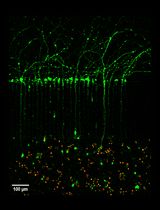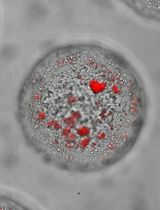- EN - English
- CN - 中文
A Novel and Robust Single-cell Trapping Method on Digital Microfluidics
一种新颖、可靠的数字微流控单细胞捕获方法
发布: 2020年10月05日第10卷第19期 DOI: 10.21769/BioProtoc.3769 浏览次数: 4008
评审: Alessandro DidonnaAnonymous reviewer(s)
Abstract
Due to cell heterogeneity, the differences among individual cells are averaged out in bulk analysis methods, especially in the analysis of primary tumor biopsy samples from patients. To deeply understand the cell-to-cell variation in a primary tumor, single-cell culture and analysis with limited amount of cells are in high demand. Microfluidics has been an optimum platform to address the issue given its small reaction volume requirements. Digital microfluidics, which utilizes an electric signal to manipulate individual droplets has shown promise in cell-culture with easy controls. In this work, we realize single cell trapping on digital microfluidic platform by fabricating 3D microstructures on-chip to form semi-closed micro-wells. With this design, 20% of 30 x 30 array can be occupied by isolated single cells. We also use a low evaporation silicon oil and a fluorinated surfactant to lower the droplet actuation voltage and prevent the drop from evaporation, while allowing cell respiration during the long term of culture (24 h). The main steps for single cell trapping on digital microfluidics, as illustrated in this protocol, include 3D microstructures design, 3D microstructures construction on chip and oil film with surfactant for single cell trapping on chip.
Keywords: Single-cell (单细胞)Background
Cellular heterogeneity within a large cell population is common. Individual cell analysis will provide more accurate information about the cell-to-cell variation masked by the stochastic average in bulk analysis. Single cell culture, which is the first step of individual cell analysis, becomes very important.
Flow cytometry is a commonly used method for single cell analysis. However, the requisition of large cell numbers (more than 10,000) hurdled its applications in the research of limited precious samples. With the merits of low sample consumption, low analysis cost, microfluidics has been pursued by many scientists, especially in the research field of limited sample acquisition and expensive reagents needed, such as cell-based drug screening. Digital microfluidics, which utilizes electric signal to manipulate individual droplet has shown its promising in cell-culture related research. However, it is difficult to realize single cell capture on a flat electrode on digital microfluidics considering several hundred nanoliter sized droplets. Although several researchers reported that they can isolate single cell on digital microfluidics, the drawbacks hindered their further applications. For example, Gidrol’s group realized single cell isolation by adjusting the concentrations of cell suspensions (Rival et al., 2014). However, the single-cell isolation efficiency was quite low. Lammertyn’s group fabricated a series of micro sized hydrophilic micropatches on an electrode for single cell trapping (Witters et al., 2011). However, the multiple hydrophilic patches resulted in higher droplet transportation voltage, which will not only shorten the chip lifetime, but also cause potential damage to cells.
In our recent work, we developed a single cell culture method for primary tumor drug screening based on microfabrication and digital microfluidic technologies (Zhai et al., 2020). In the work, 3D microstructures were engineered on digital microfluidic chips for single-cell isolation and long-time culture. With novel combination of medium oil and additives, the droplet actuation voltage was lowered to 36 V, 4 times lower than normally used. Following, breast cancer drug screening was run on-chip with the designed microstructures showing consistent results as in conventional 96-well plates.
In the present protocol, we provide detailed steps for this single cell trapping method, including experimental details to perform single cell culture with the digital microfluidic system.
Materials and Reagents
For 3D microstructures fabrication on chip
- Adhesive tape (3M, catalog number: 1183 )
- Chromium patterned bottom plate (Changsha Shaoguang Chromium Edition Company, China)
- ITO top plate (Zhuhai Kaivo Optoelectronic Technology Company, China)
- Isopropanol, abbreviate as IPA (Fisher Chemical, catalog number: 182060 )
- Acetone (Fisher Chemical, catalog number: 183005R )
- Milli-Q water (18.2 MΩ)
- SU-8 3010 (MicroChem, catalog number: 17120963 )
- SU-8 2050 (MicroChem, catalog number: 17070500 )
- SU-8 developer (MicroChem, catalog number: 18090763 )
- Amorhpous Fluoroplastics Solution (6% Teflon solution) (Chemours, catalog number: 1706ES0014 )
- N2 (Junyu company, China)
- FC-40 (3M, catalog number: 20051 )
For cell suspensions preparation
- Pipette tips10 μl (Eppendorf, catalog number: 0 224930000 )
- Pipette tips 200 μl (Eppendorf, catalog number: 0 22491296 )
- Silicone oil (Clearco, CAS number: 107-51-7 )
- Breast cancer cell lines MDA-MB-231 (ATCC, catalog number: BNCC245095 )
- RPMI 1640x basic medium (Gibco, catalog number: 11875-093 )
- Fetal bovine serum (FBS) (Gibco, catalog number: 10270-106 )
- Trypsin (Gibco, catalog number: 25200-056 )
- Pluronic® F-127, abbreviate as F127 (Sigma-Aldrich, CAS number: 9003-11-6 )
- Cisplatin (Sigma, catalog number: P4394 )
- EthD-1 (Thermo Fisher Scientific, catalog number: E1169 )
- Cell Counting Kit-8 (CCK-8) (Dojindo, Shanghai)
For single cell trapping on chip
- Pipette tips10 μl (Eppendorf, catalog number: 0 224930000 )
- Pipette tips 200 μl (Eppendorf, catalog number: 0 22491296 )
- Silicone oil (Clearco, CAS number: 107-51-7 )
Equipment
- Plasma cleaner (ABM, model: MR-200S )
- UV exposure (ABM, model: ABM-350J )
- Hot plate (Qiangyuan Instrument, model: BX-1 )
- Laser cutting machine (ZKJ Laser, Shang Hai)
- Clean bench (Lansi Purification, model: LANSI-GZ-01 )
- Cell incubator (Thermo Fisher, model: Steri-Cycle i160 CO2 incubator )
- Pipette (Eppendorf, Research plus single channel adjustable range pipette)
- Microscope (Olympus, model: BX63F )
- Cellometer (Mini, Dakewe, China)
- Microplate reader (Thermo Fisher, ID number: IED0501003M )
- Spin coater (KW-4A, SETCAS Electronics Company, China)
Software
- Auto CAD 2017 (Autodesk company)
- ImageJ (NIH government)
Procedure
文章信息
版权信息
© 2020 The Authors; exclusive licensee Bio-protocol LLC.
如何引用
Zhai, J., Li, H., Wong, A. H. H., Dong, C., Yi, S., Jia, Y., Mak, P., Deng, C. and Martins, R. (2020). A Novel and Robust Single-cell Trapping Method on Digital Microfluidics. Bio-protocol 10(19): e3769. DOI: 10.21769/BioProtoc.3769.
分类
癌症生物学 > 通用技术 > 药物发现和分析
细胞生物学 > 细胞分离和培养 > 微流体细胞培养
您对这篇实验方法有问题吗?
在此处发布您的问题,我们将邀请本文作者来回答。同时,我们会将您的问题发布到Bio-protocol Exchange,以便寻求社区成员的帮助。
Share
Bluesky
X
Copy link














